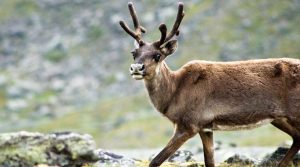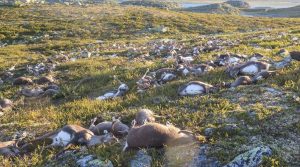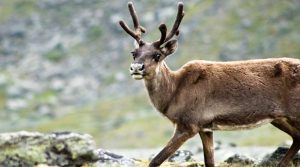AUGUST 1, 2019
 Heavy winter rains had then turned to ice, preventing reindeer from reaching their usual vegetation. (Source: Wikimedia Commons)
Heavy winter rains had then turned to ice, preventing reindeer from reaching their usual vegetation. (Source: Wikimedia Commons)
Two hundred reindeer died of starvation last winter on a remote Arctic archipelago, researchers in Norway reported, highlighting what they said were the effects of climate change on vulnerable ecosystems.
The archipelago, Svalbard, lies between the Norwegian mainland and the North Pole and is made up mostly of undisturbed natural landscapes, with its own subspecies of reindeer. The Norwegian Polar Institute has been surveying the reindeer there since 1978. According to the institute, this winter was the deadliest for the animals since a similarly fatal season in 2007-08.
Ashild Onvik Pedersen, a terrestrial ecologist at the institute, said Wednesday that climate change had increased the frequency and amount of rain in the high Arctic. Heavy winter rains had then turned to ice, preventing reindeer from reaching their usual vegetation.
Once you get the rain on the top of the snow, most often it completely freezes to solid ice that completely covers the plants, she said.
Climate change has also made for warmer and longer summers in Svalbard, helping to increase the reindeer populations. That leads to greater competition among the animals for limited food resources, putting them at greater risk of starvation.
 In this image made available by the Norwegian Environment Agency on Monday Aug. 29 2016, shows some of the more than 300 wild reindeer that were killed by lighting in Hardangervidda, central Norway on Friday Aug. 26, 2016 in what wildlife officials say was a highly unusual massacre by nature. (Havard Kjotvedt /Norwegian Environment Agency, NTB scanpix, via AP)
In this image made available by the Norwegian Environment Agency on Monday Aug. 29 2016, shows some of the more than 300 wild reindeer that were killed by lighting in Hardangervidda, central Norway on Friday Aug. 26, 2016 in what wildlife officials say was a highly unusual massacre by nature. (Havard Kjotvedt /Norwegian Environment Agency, NTB scanpix, via AP)
Estimates for Norway s total reindeer population are around 220,000. Reindeer herding is a way of life for the Sami, an indigenous people of fewer than 140,000 who inhabit mostly the northern reaches of Sweden, Norway, Finland and Russia. The total Svalbard reindeer population is not known, according to the Norwegian Arctic Institute, but monitoring of certain areas has shown an exponential rise in the number of animals. In one valley, their number grew from 400 to 1,200 between 1979 and 2013.
 Svalbard reindeer, unlike their cousins elsewhere, do not live in herds and tend to be stationary, Pedersen said. Using GPS signals, researchers found that the reindeer have been venturing far from their normal grazing areas. They have descended on the shores for seaweed and have hiked up into the rocky Arctic desert, much like mountain goats, in pursuit of the vegetation there.
Svalbard reindeer, unlike their cousins elsewhere, do not live in herds and tend to be stationary, Pedersen said. Using GPS signals, researchers found that the reindeer have been venturing far from their normal grazing areas. They have descended on the shores for seaweed and have hiked up into the rocky Arctic desert, much like mountain goats, in pursuit of the vegetation there.
In the early 20th century, the Svalbard reindeer population was severely depleted by hunting. The animals have been a protected species since 1925 in Norway, helping the population recover. Over 40 years of monitoring has allowed researchers to observe changes precisely, including those resulting from climate change.
The Arctic has been warmer over the past five years than at any time since records began being kept in 1900, and the region has been warming at twice the rate as the rest of the planet, a report last year by the U.S. National Oceanic and Atmospheric Administration said.
Across Arctic regions in Russia, northern Scandinavia and Greenland, wildfires are common in the summer. But this year, the number and intensity of the fires made for an unusual sight, burning huge sections of the Arctic and unleashing plumes of smoke visible from space. Mild spells have been a rare phenomenon in Svalbard, but they have increased in frequency in recent years, Pedersen said.
Watch:Scientist’s Map Explains Climate Change (Dailymotion)
The effects of climate change are beginning to show, scientists say, with Pedersen and others warning of the effects on reindeer and other species in Svalbard as far back as 2013.
Icing is predicted to become more frequent in the circumpolar Arctic and may, therefore, strongly affect terrestrial ecosystem characteristics, they wrote in an article in Science.
More recently, in April, a study published in the Ecological Society of America s Ecosphere journal found that the animals were increasingly isolated by the lack of sea ice on the one hand and the presence of ice-covered pastures, a result of rain during extreme warm spells, on the other.
Dozens, even hundreds, of the animals have been wiped out by various calamities over the years. In 2017, more than 100 reindeer were killed in a four-day period by freight trains rolling through Norway, prompting an outcry for the national railway to do more to protect the animals.
In 2016, more than 300 reindeer, huddled together in a storm, were killed by lightning on the Norwegian mainland, their carcasses left sprawled across a hillside on the Hardangervidda Mountain plateau. But that episode ended on a hopeful note.
The bodies of the animals became a laboratory, attracting scavengers from around the region that left in their feces an unusual concentration of plant seeds from the area, potentially spawning new plant diversity, Norwegian scientists said.
Courtesy/Source: Indian Express










































































































